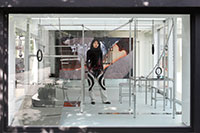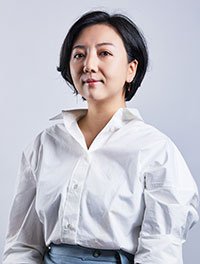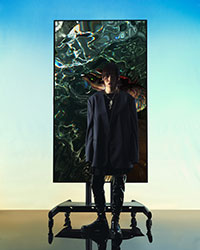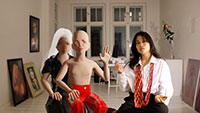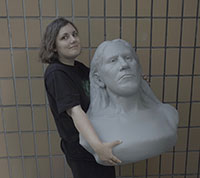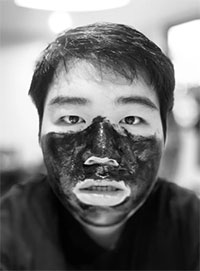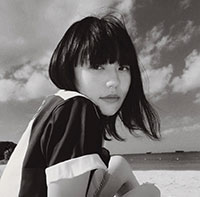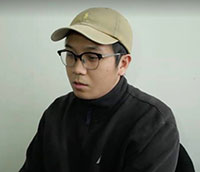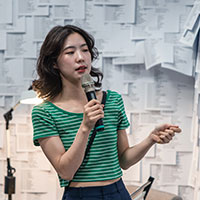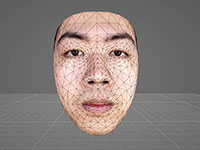전시
-
2023 아르코미술관 X 디지털아트페스티벌 타이베이 스크리닝 프로그램
- 전시기간
- 2023.11.03~2023.11.26
- 관람료
- 무료
- 오프닝
- 장소
- 아르코미술관 1층 공간열림
- 작가
- 김효재, 소피아 이완누 게딩, 신 천, 신카 친화 양, 안가영, 위량 린, 이은솔, 즈이 천, 천 천, 추수
- 부대행사
- 주관
- 아르코미술관
- 주최
- 한국문화예술위원회
- 문의
- 02-760-4850
2023 아르코미술관 X 디지털아트페스티벌 타이베이 스크리닝 프로그램
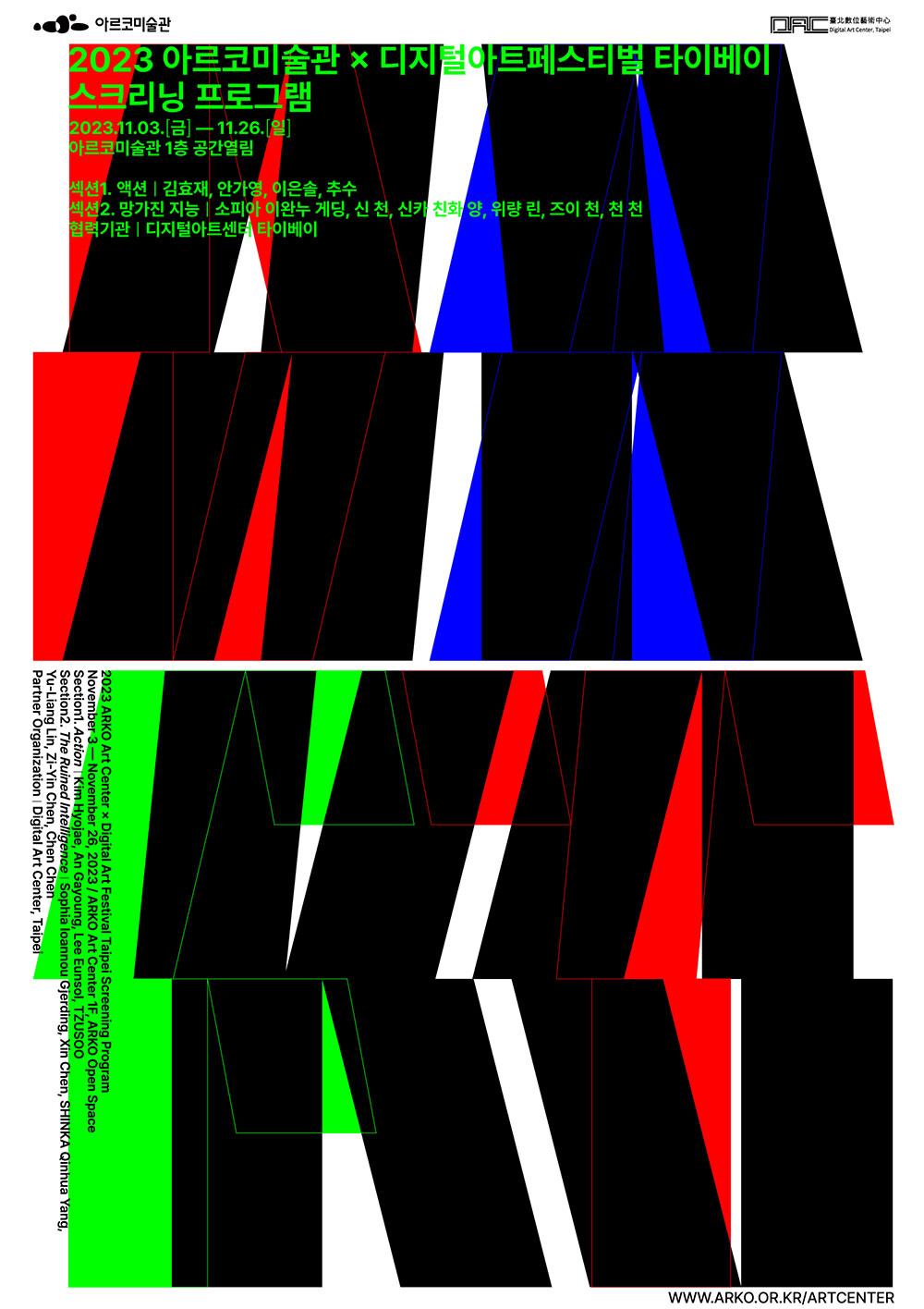
《2023 아르코미술관 × 디지털아트페스티벌 타이베이 스크리닝 프로그램》
섹션 1. 액션, 섹션 2. 망가진 지능
- 기간 : 2023.11.3. ~ 2023.11.26.
- 운영시간 : 화-토요일, 11시-19시(매주 월요일 휴관)
- 장소 : 아르코미술관 1층 공간열림
- 작가 : 김효재, 소피아 이완누 게딩, 신 천, 신카 친화 양, 안가영, 위량 린, 이은솔, 즈이 천, 천 천, 추수
- 관람료 : 무료
- 주관 : 한국문화예술위원회
- 협력기관 : 디지털아트센터 타이베이
▣ 프로그램 소개
2023 아르코미술관 × 디지털아트페스티벌 타이베이 스크리닝 프로그램은 2022년에 이어 두 번째 협력프로그램을 공동 개최합니다. 이번 프로그램은 제18회 디지털아트페스티벌 타이베이의 주제전 《A-Real Engine》과 연계하여 게임이 현실(Reality)이 된 오늘날 게이밍의 개념과 요소를 통해 새로운 서사를 만들고, 게임의 메커니즘을 해체하거나 시스템의 통제를 벗어날 방법을 찾고자 합니다. 이번 프로그램은 작가 10인의 영상 작품을 섹션1. 액션, 섹션2. 망가진 지능 두 섹션으로 선보입니다.
*이 프로그램은 디지털아트페스티벌 타이베이(Digital Art Festival, Taipei)의 협력 프로그램으로 디지털아트센터 타이베이(Digital Art Center, Taipei)에서 동시 개최됩니다.
▣ 섹션 소개
섹션1 | 액션
‘섹션1. 액션’은 AI 제네레이터, 온라인 게임 플랫폼, 게임엔진과 같은 기계장치에 의해 생성되는 가상 환경의 기술적 제작, 게임 속 캐릭터와 환경자원을 사용한 게임적인 연출과 서사를 드러내는 영상작품을 선보인다. 사회의 관계망과 조건은 게임의 배경과 환경이 되었다. 오늘날 게임엔진이 만들어 낸 가상세계를 독립된 세계로 분리하기란 어렵다. 게임이 현실을 재현하거나 현실의 조건을 전제로 삼기 때문이다. 기술미디어에 의해 삶과 사회의 모습은 재현되며, 게임 속에서 현실은 고스란히 노출된다. 게임이나 가상현실은 이제 미학적 양식과 경험으로서 사회를 반영하기도 하고, 사회의 변화를 야기하는 매체가 되었다. ‘섹션1. 액션’에서는 머시니마(Machinima)와 같이 디지털환경과 게임의 문법, 제작방식을 비디오 서사연출의 형식으로 활용하는 영상작품에 주목한다. 이 작품들에서는 디지털 가상공간이 사회의 지식 체계와 규범이 되먹임(Feedback Loop)되어 드러나는 공간으로, 또는 이 체계에서 벗어난 해방의 공간으로, 혹은 비인간의 공간으로 정의되며, 우리 현실과의 얽힘을 제시한다.
안가영의 〈KIN거운 생활: 온라인〉은 게임플랫폼에 사람들을 초대하고 가상공간 안에서 실제로 있었던 상황을 재현한 머시니마 영상이다. 가상공간을 활용하는 윤리적이고 현실적 문제에 봉착한 인물들은 이를 바탕으로 게임 안에서의 규범, 안전한 활용을 제안한다. 한편, 버추얼 인물들은 가상에서 탄생한 존재이지만 가상의 프레임 밖으로 이행하여 현실의 환경에서 작동한다. 이은솔은 가상의 인물 ‘킴벌리’를 디지털 네트워크 안에서 자유롭게 변형하고, 확장시킬 공동운영 조직을 만든다. 이 조직은 디지털화된 가상자산을 발행하고, 킴벌리를 자원삼아 2차 창작과 소유권의 공동 소장을 통해 디지털 기반의 커뮤니티의 모델을 상상한다.
추수는 AI 제너레이터 DALL·E2와 협업으로 버추얼 인플루언서 ‘에이미’를 창조하고, 에이미를 디지털 네트워크에서의 다양한 활동으로 확장시키는 작업을 전개한다. 기계장치가 창조한 에이미는 인간과 독립된 세계 속 존재로 살아가지만 에이미의 영향력은 육체가 있는 현실세계에 닿는데, 이 존재는 여러 세계들이 얽힌 포스트휴먼의 조건을 가진다.
김효재의 〈파쿠르〉는 사회 안에서 되먹임으로 재생산되는 데이터와 그 한계를 보여준다. 그는 규칙과 기준, 형태를 거부하는 무형식의 운동인 파쿠르와 이를 수행하는 사람들의 몸짓을 좇는다. 알고리즘과 AI 파쿠르 로봇이 파쿠르 움직임을 표준화하거나 움직임의 다양성을 제한한다는 사실은 데이터에 예속된 신체를 상기하게 한다. 파쿠르 수행자들은 데이터에 예속되기보다 저마다 다른 신체적 조건 안에서 한계범위를 넘는 역량을 경험하면서 신체 움직임의 다층적 펼침을 수행한다. 이 움직임은 인간이 수행할 수 있는 창작활동과 근원적인 미적 경험으로 전해진다.
(기획 | 아르코미술관)
섹션2 | 망가진 지능
고전 고대 때부터 회화는 사실의 재현을 향해 나아갔다. 현대 과학기술의 발전에 힘입어 이제 현실의 재현이라는 전투의 장을 컴퓨터로 옮겨 오게 되었고, 그래픽 소프트웨어 도구를 활용하여 현실 세계만큼이나 사실적인 가상 세계를 창조하기 위해 분투하고 있다. 동시대인들의 삶은 클라우드 연산과 사회관계망에 많은 부분 의존하고 있으며, 심지어 인공지능과 자동 생성 기술로 인해 이미 두 세계가 모두 “현실”이라고 불리는 세계에 살고 있기도 하다.
거대한 보이지 않는 손이 자본주의 세계의 작동을 추동한다. 모든 접속과 커뮤니티와 게임 세계에서의 행위는 비물질 노동의 축적이며, 우리는 게임을 즐기는 향유자인 동시에 노동력의 제공자이다. 거대한 생산의 연쇄 가운데 사람들은 유사한 언어와 미감을 학습하고, 생각이 비슷한 사람들과 어울림으로써 안전함을 획득하며, 주류 미학에 충분히 부합하지 못하거나 틀린 말을 내뱉는 것을 극도로 두려워한다. 그러나 우리가 이렇게 동화되었다고 느끼는 것마저도 빅데이터 연산이 가져다준 “연관성이 높은” 응답일지 모른다. 익명성과 동일화, 불순함의 소멸은 이미 마주하고 있는 동시대의 위기이다. 우리의 일과 삶의 편의를 위해 인공지능에 의존할수록 인간과 컴퓨터 프로그램의 관계는 공고해지고 조건화되는 것이다.
영화 「프리가이」(2021)에서 주인공 가이는 오픈월드 게임의 한 논플레이어 캐릭터(NPC)로 등장한다. 가이는 게임의 기본 설정의 부분으로써 다른 NPC들과 함께 은행원이라는 역할을 플레이하며 반복적인 일상을 살아간다. 어느 날, 그는 자신의 자의식을 발전시키게 되는데, 외부에서 접속하는 플레이어들과 상호작용을 주고받다가 게임 세계 내에서 혁명을 주도한다. 우리 모두는 가이인 셈이다. 우리는 모든 것이 최초의 설정값(Default)으로 흘러갈 수 있도록 현실의 세계나 인터넷에서 각자 맡은 역할을 성실히 소화해내는 것이다.
생명의 진화가 변이를 필요로 하듯, 문명의 발전 또한 사건과 혁명을 필요로 한다. 우리가 존재한다는 것을 확인하기 위해 인류로서 우리의 주체성을 깨닫는 유일한 길은 “오류”를 발견하는 순간이다. 이번 스크리닝 프로그램에서는 세 명의 대만 작가의 작품과 세 편의 오픈콜 선정작을 함께 선보인다. 작품들은 다양한 관점으로부터 과학기술 도구와 삶의 관계, 도구의 한계와 변경 안팎을 탐구하며, 나아가 컴퓨터 게임 플레이어로서의 경험을 통해 자아의 정의를 탐색한다.
(기획 | 디지털아트센터 타이베이)
▣ 작품 소개
섹션1. 액션
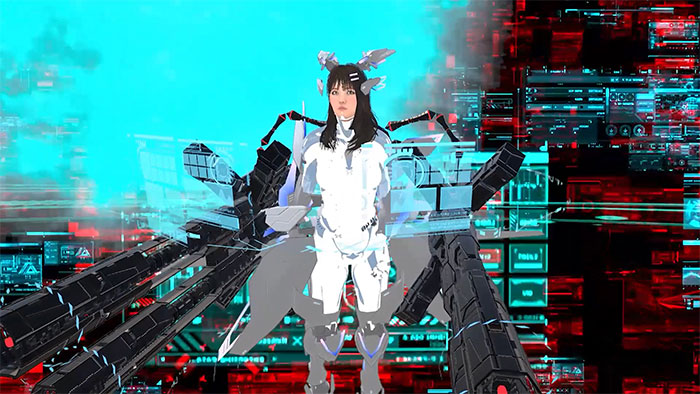
안가영, 〈KIN거운 생활: 온라인〉, 2020-2021, 머시니마, 단채널 Full HD 비디오, 컬러, 사운드, 20분 13초
〈KIN거운 생활: 온라인〉은 메타버스 플랫폼 브이알챗(VRChat)에서 가상의 난민 아바타인 혜지, 민지, 지혜의 이야기를 옴니버스식으로 구성한 머시니마(Machinima) 영상이다. 온라인 플랫폼에 접속한 예술가들은 게임 속 신체에 부적응한 이들의 캐릭터로서 역할극을 하며, 가상 현실에서 억압받는 자들의 연합을 꿈꾼다. 혜지는 오랫동안 제작해온 자신의 아바타를 게임 설정을 해제하는 실수로 다른 이에게 빼앗긴다. 민지는 현실에서 이루지 못한 꿈을 가상 환경 안에서 실현하고자 했으나, 빠르게 변화하는 기술에 적응하지 못하고 게임 안에서 투명 인간이 된다. 지혜는 자신의 아바타가 온라인상에서 성희롱과 착취를 당하고 있는 캐릭터라는 사실에 분노하며 신체 개조를 통해 사이보그 트롤러로서 활동한다. 기술의 사각지대에서 소외받고 상처받은 이들은 온라인 피난처인 킨 쉘터(KIN Shelter)에 모여 서로를 보듬고, ‘예술가들을 위한 가상세계 튜토리얼’을 작성하며 온라인에서의 윤리와 규칙에 대해 함께 고민한다.
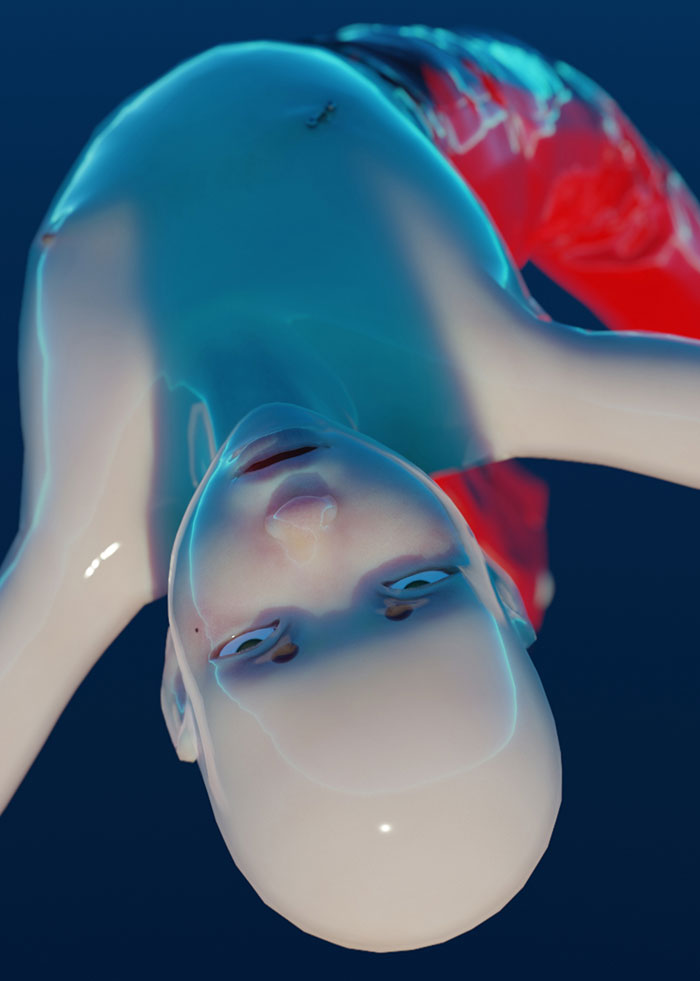
추수, 〈사이보그 선언문〉, 2021, 단채널 비디오, 컬러, 사운드 10분 41초
영상은 버추얼 인플루언서이자 액티비스트로 활동하는 에이미 문의 실존과 도나 해러웨이의 「사이보그 선언」(1985)을 겹쳐 놓는다. 에이미를 마치 SF영화의 사이보그처럼 “자연적인지 인공적인지 모호한 세계에 사는 동물이자 기계인 피조물”과 같은 존재로 비유한다. 사이보그처럼 에이미는 “기계와 유기체의 잡종”이자 “상상과 물질적 실재가 응축된 이미지”인 것이다. 작가는 이 가상의 인물 에이미를 현실의 규범과 역사, 고정된 세계를 배반하는 실체로 상정한다. 작가에게 에이미는 현실 세계를 반영하는 허구적 존재이면서 규범과 문법에 파열을 내며 경계를 무화하는 가상세계의 가능성의 자원이다. 영상은 저명한 선언문을 읊으며 에이미가 만들어나갈 새로운 세계의 질서와 정체성을 선언한다.
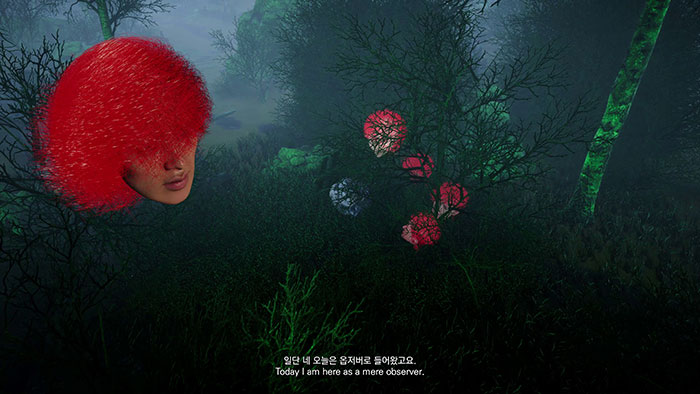
이은솔, 〈다함께 신탁을 기다리세요〉, 2023, 단채널 비디오, 컬러, 사운드, 11분 4초
〈다함께 신탁을 기다리세요〉는 킴벌리(Kimberly Lee)의 공동 육성과 공동 작업을 위해 모인 공동조직 킴벌리 다오(Kimberly DAO)가 발행한 가상화폐의 분배와 규칙, 미래의 킴벌리의 방향에 대한 구성원들의 대화를 담는다. 다오의 구성원들은 킴벌리라는 가상 인물이 전개할 수 있는 아이디어와 개념을 확장하는 여정을 공유하며, 탈중앙화된 디지털 조직이 형성하는 커뮤니티의 감각, 디지털적인 연결을 탐색한다.
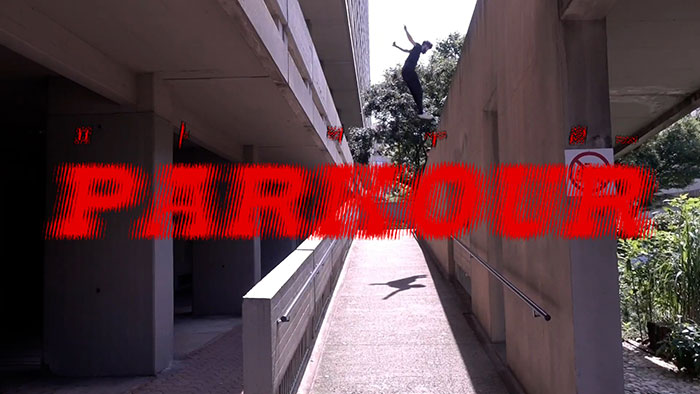
김효재, 〈파쿠르〉, 2021, 단채널 비디오, 컬러, 사운드, 33분 21초
ʻ여정’을 뜻하는 프랑스어 ʻparcours’에서 유래한 파쿠르는 인간의 몸으로 도시나 자연환경의 다양한 장애물들을 극복하는 신체 훈련 방법이다. 파쿠르는 일상적인 공간에서 기존의 규칙을 벗어나 움직임을 끊임없이 만들어낸다. 신체를 손상시킬 수 있는 극한의 상황 속에서 반복적인 신체수행을 통해 신체와 정신의 합일점을 찾는 파쿠르는 몸을 가진 내가 누구인지 질문하는 움직임으로 보여진다. 점프, 추락과 같은 속도감 속에서 몸에 달린 카메라의 시점으로 드러나는 신체의 움직임은 온라인 게임에서의 시점을 연상시킨다. 영상은 인터넷을 통해 유통되는 파쿠르 움직임에 대한 알고리즘이 파쿠르의 다양성을 단순화하고 있음을 가시화하고, 스포츠로서 획일적으로 데이터화된 움직임에서 벗어나기를 제안한다. 이는 몸의 경험을 확장하고 수행하는 가능성으로서의 움직임(Movement)을 포착하고자 하는 것이다.
섹션2. 망가진 지능
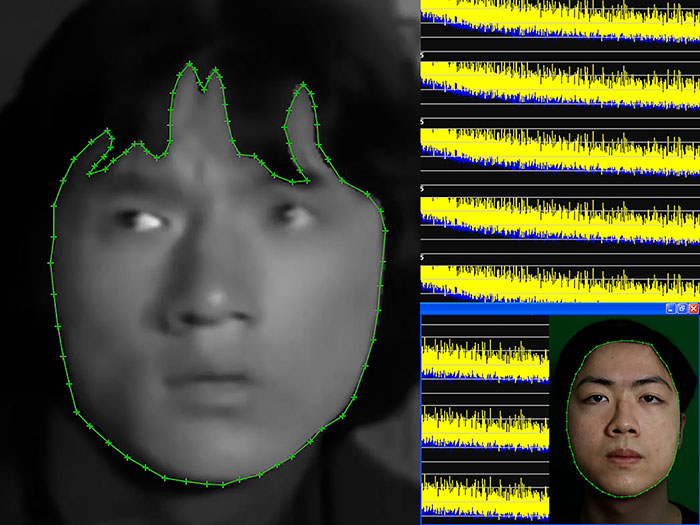
천 천, 〈모방 수련〉, 2022, 단채널 비디오, 컬러, 사운드, 7분 30초
영화 「사형도수」(1978)에서 주인공을 맡은 배우는 모방을 통해 무술을 배운다. 이 영상은 딥페이크를 이용해 쿵후 영화 스타가 되려고 하는 작가의 유년기 꿈에 주목한다. 그 과정에서 연습과 계산, 무술과 기술, 배우 성룡과 작가의 자아는 서서히 하나가 된다. 기술이 더 이상 기술을 참고하지 않을 때 향수의 도구가 되게 마련이다. 이 영상은 작가와 쿵후 영화와의 관계가 단순한 시청자에서 협력 에디터로 변화하는 과정과 물리적 인터페이스가 서서히 디지털화되어 인공적 인터페이스로 변해가는 과정을 담고 있다.
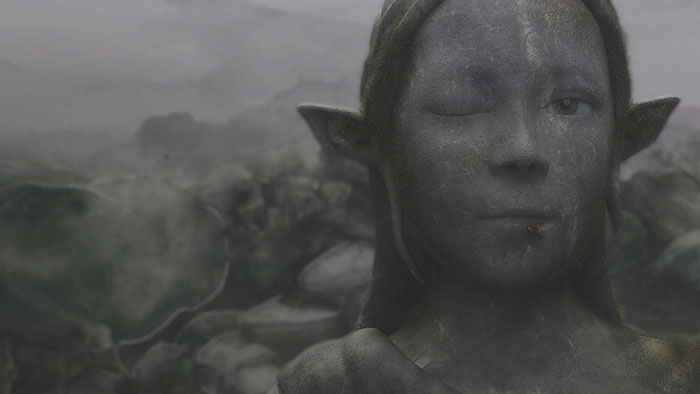
소피아 이완누 게딩, 〈에어웨이에 대한 경의〉, 2019, 단채널 비디오, 컬러, 사운드, 12분 25초
이 영상은 다양한 역사적 인물들과 컴퓨터 게임에서 조작이 불가능한 캐릭터들을 비교하여 행위자성을 살피고, 역사가 서술되는 이미지 체제를 재평가함으로써 역사의 비주류 인물들에게 어떻게 새로운 행위자성이 주어지는지를 묻는다. 〈에어웨이에 대한 경의〉는 에어웨이라는 이름의 개를 담은 1920년대 사진 한 장에서 출발한다. 에어웨이는 마취과 의사 두 명의 손에 자란 반려동물이자 실험동물이다. 또 하나의 출발점은 프레드리히 빌헬름 볼프가 1847년에 제작한 청동상이다. 이 동상은 독일의 첫 마취제 실험을 풍자적으로 묘사한 것이었고, 마취 대상은 베를린 동물원의 눈먼 늙은 곰이었다. 영상 속 개와 곰은 두 세계관 안에서 진행되는 이야기에 등장한다. 관객은 현실과 뒤엉킨 가상의 시나리오 두 개를 목격하게 된다. 전체 작품을 아우르는 인물은 브로큰 페이스라는 논플레이어 캐릭터로 화석화된 콘솔 게임 캐릭터와 조각품의 혼합체이다. 이 영상은 간과하기 쉬운 이야기들을 내세워 동시대적 배경 속에 역사적 소재들을 배치한다. 이러한 지점에서 작가는 우리가 생산하고 우리의 주변을 에워싸는 이미지들을 통해 세상을 바라보는 방식에 질문을 던진다. 〈에어웨이에 대한 경의〉는 이미지의 지위에 관한 것이자, 우리가 이미지와 더불어 살며 기존의 이미지를 재코드화하는 방식에 대해 말한다.
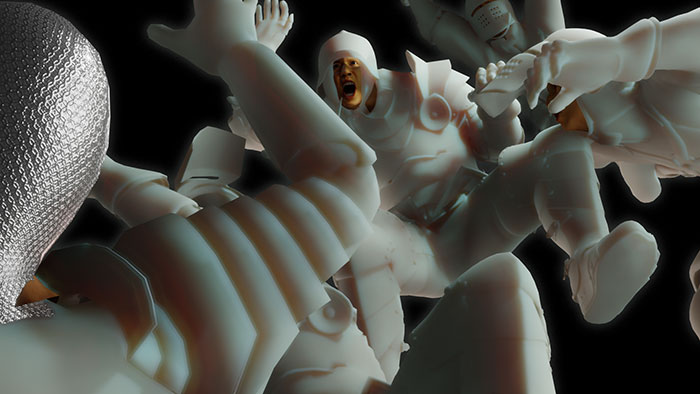
위량 린, 〈내 손에 쥔 것은 최고의 검!〉, 2023, 단채널 비디오, 컬러, 사운드, 6분 35초. 디지털아트페스티벌 타이베이 제작지원
게임 속 아이템, 무기, 탈 것 등은 모두 캐릭터의 능력치를 끌어올려주는 것들이다. 강력한 무기는 캐릭터의 능력치를 더욱 높은 단계로 향상시켜주기 때문에 무기를 모으는 것이 게임에서 중요하게 여겨진다. 가장 강력한 아이템을 얻거나 게임 내 버그를 이용해 자원을 대거 축적하면 게임은 결말로 향해가는데, 이는 게임플레이 경험을 종결시킨다. 이 작업은 “무기 상점”(The Weapon Shop), “깨진 병 안에 숨겨진 위업”(The Exploits Hidden in a Broken Bottle), “싸울 준비를 마친 완전무장한 기사”(The Full-armed Knight Ready to Fight) 등의 대상을 등장시키며, 전동 휠체어의 속도를 향상시켜 선보였던 이전 개인전 《마을 주민 A》의 연장선상에 있다. 휠체어는 작가가 “템플 기사단”(Knights Templar)이라 부르는 존재들을 가로막는 거대한 장애물이기도 하다. 작가는 게임 메커니즘과 캐릭터 특성을 혼합함으로써 기술 장치와 삶 사이의 관계에 응답하고자 한다.
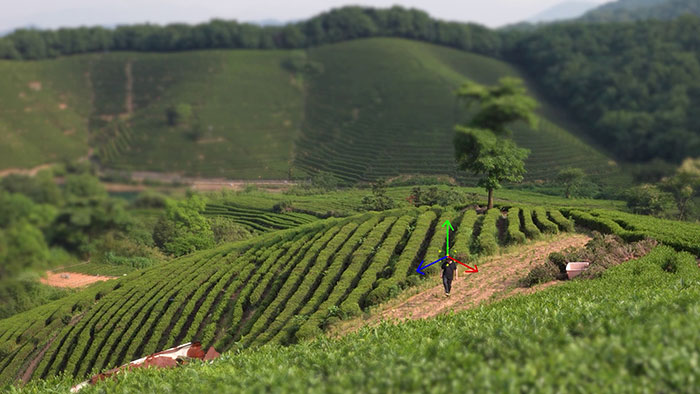
신 천, 〈움직이는 남자〉, 2022, 단채널 비디오, 컬러, 사운드, 6분 27초
〈움직이는 남자〉는 산을 움직인 유공이라는 남자에 대한 중국의 유명한 우화에 대한 것이다. 작업의 제목은 기존 우화의 제목을 변형한 것으로, “움직이는 남자가 산을 속이다”는 뜻으로 읽힌다. 신체로 땅을 측정하는 전통적인 방법은 위성 기술과 디지털 혁명으로 인하여 더 이상 유효하지 않은 방식이 되었지만 그 방법으로 공간의 가능성을 탐구할 여지는 여전히 남아있다. 기계 생산의 목적에 닿기 위해 새로운 사용자 커뮤니티는(센서, 스마트 자동차, 드론, 로봇 청소기, 클라우드 컴퓨팅 등의 부상과 함께) 신체 측정을 포함하지 않는 새로운 지형학적 위상 구조에 기여한다. 이 영상은 작가가 제작한 기기를 착용하고 산을 넘으며 그 산의 지형 모델을 만드는 과정을 기록한 것이다. 발걸음 하나 하나가 새로운 가상 공간 안에 고도, 위도, 경도, 시간 정보를 포함한 연속적인 좌표를 만들어낸다. 이렇게 수집된 정보를 토대로 컴퓨터 그래픽을 통해 이 산은 가상 공간 속에 재현된다.
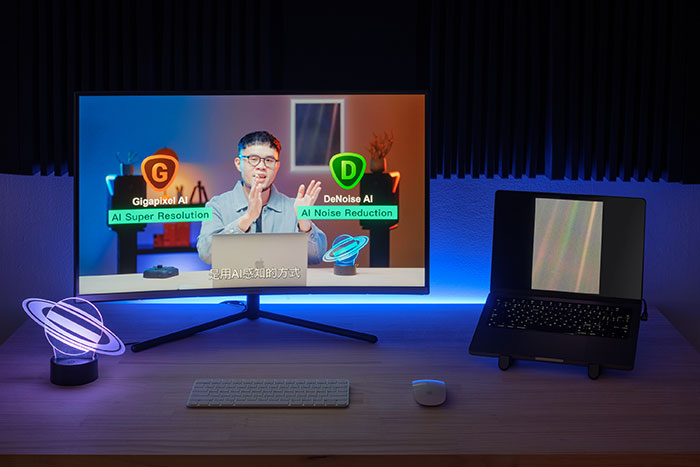
즈이 천, 〈AI로 사진 화질을 개선하는 방법 | 노이즈 제거, 초고해상도 튜토리얼〉, 2022, 단채널 비디오, 컬러, 사운드, 10분 40초
1990년, 천문학자 칼 세이건(Carl Sagan)의 주도로 우주선 보이저 1호가 지구의 모습을 촬영한 사진은 창백한 푸른 점(Pale Blue Dot)이다. 노이즈로 가득한 이 사진 속에서 지구는 0.12 픽셀에 해당되는 하얀 점에 불과하다. 방대한 양의 데이터 트레이닝을 거치면 인공지능 모델이 예외 데이터의 영향을 덜 받아서 적응력이 강화된다. 하지만 인공지능의 노이즈 절감 모델은 창백한 푸른 점에 나타나는 지구의 모습을 노이즈로 인식하고 지워버린다. 초고해상도 인공지능 모델의 12개의 새로운 해상도는 인류와 지구가 없는 세상을 상정한 것일까? 이 영상은 인기 있는 온라인 튜토리얼의 형식을 취하고 있는데, 등장 인물이 창백한 푸른 점을 이용하여 인공지능 이미지 편집 소프트웨어 사용법을 가르쳐 준다. 주인공이 이미지 노이즈 제거와 고해상도 이미지 생성 방법을 설명하면서 고화질 창백한 푸른 점을 만들어낸다. 이와 함께 칼 세이건의 연설 “이 점을 다시 한번 봐주십시오”가 영상에 삽입되어 있다. 이 미세한 푸른 점은 망상과 같은 인간의 특권의식에 도전하고 과학적 이미지를 통해 확장된 거리에 대한 인간의 인식을 풀어헤친다.
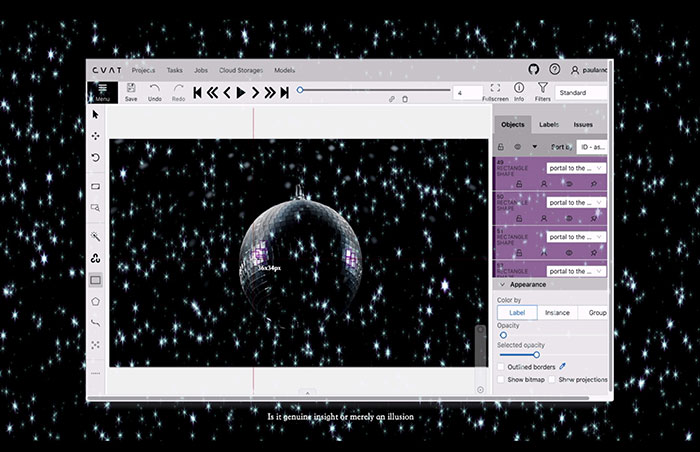
신카 친화 양, 〈풍경 길들이기: 무의미한 윤곽들〉, 2023, 단채널 비디오, 컬러, 사운드, 9분 35초
우리 일상 속 다양한 상황에 적용되는 인공지능의 자동 이미지 인식 시스템은 광범위한 인간 노력의 산물로, 방대한 양의 이미지 데이터에 반복적으로 “라벨”을 붙인 뒤, 머신러닝 트레이닝을 거쳐 나온 결과물이다. 라벨을 붙이는 과정에서 역동적으로 직조된 우리의 삶은 기계가 읽을 수 있는 조각난 이미지로 전락했다. 기계의 눈은 이 세상을 해체하고 의미를 부여하는 능력을 습득한 것처럼 보인다. 이 영상은 컴퓨터 이미지 인식 기술을 기반으로 한 예술 실험이다. 작가는 일상의 풍경을 데이터 주석 소프트웨어를 이용하여 “감정적인” 태그로 레이블링하고 시각 보고서를 생성해 기계의 “공정성”에 도전한다. 영상은 관객에게 기계의 눈이 실제로 통찰력을 가지는지, 혹은 허상일 뿐인지 고민하게 한다.
▣ 참여작가 소개
- 리플릿(PDF) : 바로가기
자료담당자[기준일(2023.11.2.)] : 미술관운영부 노해나 02-760-4607
게시기간 : 23.11.2. ~
2023 ARKO Art Center × Digital Art Festival Taipei Screening Program

2023 ARKO Art Center × Digital Art Festival Taipei Screening Program
Section 1. Action / Section 2. The Ruined Intelligence
- Date : November 3 – November 26, 2023
- Opening Hours : Tue – Sat, 11am – 7pm(Closed on Mondays)
- Venue : ARKO Art Center 1F, ARKO Open Space
- Artists : Kim Hyojae, Sophia Ioannou Gjerding, Xin Chen, SHINKA Qinhua Yang, An Gayoung, Yu-Liang Lin, Lee Eunsol, Zi-Yin Chen, Chen Chen, TZUSOO
- Admission : Free
- Host : Arts Council Korea
- Partner Organization : Digital Art Center, Taipei
▣ Introduction
The 2023 ARKO Art Center × Digital Art Festival Taipei screening program is the second of its kind since it first started in 2022. This year, the program is curated in conjunction with the 18th Digital Art Festival Taipei theme exhibition entitled A-Real Engine. The exhibition seeks for ways to create new narratives with today’s gaming concepts and features that turn games into reality, as well as ways to deconstruct the game mechanism or break free from the system’s control. Videos created by 10 artists ─ each selected by ARKO Art Center and the Digital Art Center, Taipei ─ are showcased in two sections, Action, The Ruined Intelligence in accordance with the theme of the exhibition in Taipei.
*This program is held in collaboration with the Digital Art Festival Taipei and will be held at ARKO Art Center and Digital Art Center, Taipei simultaneously over the same period.
▣ About the program
Section1 | Action
Section 1, entitled Action, features video works that present the technological production of virtual environments created with mechanical devices such as AI generators, online game platforms, and game engines, and also involve game-like directing and narratives that use in-game characters and environmental resources. Our social relationships and conditions are reflected in the game world, in its background and environment. It has now become difficult to differentiate the game engine-created virtual world from reality. This is because games are reproductions of reality, or because the conditions of reality are their premises. As such, our lives and society are represented by means of technological media, and it is in the game world that reality is wholly revealed. Games and virtual realities either reflect or change society in terms of aesthetic styles and experiences. Section 1 Action focuses on video works that deploy digital environments, game grammar, and production methods as their storytelling processes such as machinima. In these works, the digital virtual world is a space where social knowledge systems and norms appear in a feedback loop. Defined as non-human spaces of emancipation that have broken away from the systems, it is demonstrated how these worlds are interwoven with our reality.
An Gayoung’s KIN Online is a machinima video that recreates situations that actually occurred in an artificial space with the people who were invited to the game platform. Based on ethical and realistic issues experienced within the virtual space, the characters propose alternative rules and safety guidelines for the game.
Meanwhile, virtual characters move out of the frame from the virtual space they were born and function in the real world. Lee Eunsol created a collaborative organization that can freely transform and expand the virtual character named “Kimberly” within the digital network. This organization issues digitalized virtual assets and uses Kimberly as a resource to imagine a digital-based community model and its activities by sharing secondary creations and their rights.
TZUSOO, in collaboration with AI generator DALL·E2, has created the virtual influencer “Aimy” and expanded it in diverse realms through the digital network. Created by a mechanical device, Aimy lives on as a being that belongs to a world that is independent of humans, but her influence eventually reaches into the real world of bodies. As such, Aimy appears to hold the conditions of a post-human being where different worlds are intertwined together.
Kim Hyojae’s Parkour illustrates the limitations of data that is reproduced in a feedback loop within our world. The artist explores bodily movements and the related data of the people who practice parkour, a formless sport that refuses rules, standards, and forms. The fact that algorithms and AI parkour robots standardize parkour movements or limit the diversity of physical movements reminds us of the body subjugated to the data system. The parkour performers are not governed by datafication, but instead express abilities that surpass each of their different physical limitations and carry out body movements at different levels. These movements are seen as creative activities that can be performed by human beings as well as original aesthetic experiences.
(Curated by ARKO Art Center)
Section2 | The Ruined Intelligence
Since classical antiquity, the art of painting has aimed to represent reality. With the development of modern technology tools, we now move the battlefield of reality representation to the computer, endeavoring to use graphic softwares to create a virtual world that is almost identical to the real world. However, modern people rely heavily on cloud computing and social networks in their life. Now, with the technological maturation of AI and automatic generation programs, we have been living in the two worlds that are both named “reality.”
A giant, invisible pair of hands is pushing the capital world forward. Every log-in and action in the social networks and the gaming world is an accumulation of immaterial labor. We are providing labor while feeling enjoyed and entertained. In this massive production chain, people learn similar languages and aesthetics, mingling with like-minded others to obtain a sense of security. They fear being ostracized for saying something wrong or not acting in line with the aesthetic mainstream. However, when we feel being identified with, perhaps it is just that the big data computing has given us a “more proper” response. Anonymity, assimilation, and the disappearance of impurities have become a contemporary crisis. When we increasingly depend on AI to assist us with work and daily life, the relationship between humans and computer programs has become rigid and conditioned.
In the movie Free Guy (2021), the protagonist Guy is a non-player character (NPC) in an open-world game. Guy has lived a repetitive life, playing the role of a bank clerk with other NPCs as part of the basic setting supporting the game. One day, Guy develops his own awareness. He begins to interact with players logging in from outside and initiates a gaming revolution. Each of us is a Guy. We diligently play our own roles in the real world or on the Internet, to ensure that everything goes by default.
A civilization takes events and revolutions to grow, much as mutation is needed for the evolution of life. To make sure we exist, it seems the moment of finding “errors” is the only way for us to realize our agency as human beings. In the screening program, three Taiwanese artists have presented three works, while another three works have been selected via a call for submissions. These videos examine the relationship between technology tools and life, and the limit/boundary of tools from different perspectives, as well as explore the definition of self through the experience of a video game player.
(Curated by Digital Art Center, Taipei)
▣ Artwork Introduction
Section1. Action

An Gayoung, KIN Online, 2020-2021, machinima, single-channel Full HD video, color, sound, 20min 13sec
KIN Online is a machinima video that delivers the stories of three virtual refugee avatars — Hyeji, Minji and Jihae — in an omnibus style in VRChat, a metaverse platform. The artists enter the online platform and play the characters, but maladjusted to their in-game bodies, hoping to form an alliance with the oppressed in the virtual world. Hyeji spends a long time building her avatar only to have it stolen by another player after mistakenly changing the game setting. Minji plans to fulfill her dream in the virtual world that she could not continue in the real world, however, fails to adapt to the fast-changing technology and becomes an invisible person in the game. In rage after finding out her avatar is a victim of sexual harassment and exploitation in the online world, Jihae becomes a cyborg troller through body augmentation. The alienated and hurt in the blind zone of technology take care of each other in the online refuge, KIN Shelter, and create “Virtual Tutorials for Artists” where they contemplate ethics and rules in the online world.

TZUSOO, The Cyborg Manifesto, single-channel video, color, sound, 10min 41sec
The video overlaps the existence of the virtual influencer and activist Aimy Moon with “A Cyborg Manifesto” (1985) written by techno-scientist Donna J. Haraway. It assimilates Aimy to a sci-fi film cyborg, defined as “a creature that is an animal and also a machine, living in an ambiguous world which cannot be clearly described as either natural or artificial.” Like a cyborg, Aimy is a “hybrid of machine and organism” and has a “mixed image derived from imagination and physical reality.” The artist positions the virtual figure Aimy as the real image that betrays the norms of reality and the knowledge system of the fixed world. To the artist, Aimy is a fictional entity that reflects the real world, and a potential resource of the virtual world that blurs the boundaries between the real and virtual by breaking the norms and rules. Alongside the prominent manifesto, the video declares the new world order and identity that Aimy will be creating.

Lee Eunsol, Wait for the Trust Together, 2023, single-channel video, color, sound, 11min 4sec
Wait for the Trust Together portrays the collective care and creation of the virtual figure Kimberly Lee and the conversation between the members of Kimberly DAO about the distribution of virtual currency and its rules, as well as Kimberly’s future direction. The members of DAO share the journey where they can expand the ideas and concepts that the virtual character Kimberly is able to develop, exploring the sense of community formed by a decentralized digital organization and its digital connection.

Kim Hyojae, Parkour, 2021, single-channel video, color, sound, 33min 21sec
“Parkour” originated from the word parcours, which means “journey” in French. It is an athletic training discipline that involves overcoming various obstacles in urban or natural environments with the human body. Parkour continuously creates movements that escape conventional rules in ordinary spaces. Through repetitive physical training under extreme conditions that could plausibly damage the body, parkour is shown as the act of discovering the point of unity between the body and mind and questioning the self with a physical body. The perspective of the camera attached to the body involving speedy physical movements such as jumps or falls resembles that of online games. Parkour suggests to escape the algorithms of parkour movements distributed through the Internet, which simplify the diversity of parkour and reduce it into uniform data as a sport. It attempts to capture movements as opening the possibility of expanding and performing the bodily experience.
Section2. The Ruined Intelligence

Chen Chen, Imitation Training, 2022, single-channel video, color, sound, 7min 30sec
In the movie Snake in the Eagle’s Shadow (1978), the lead actor undergoes training in the martial arts through imitation. Through deepfakes, the present work zeroes in on childhood memories of pretending to be kung fu movie stars. In the process, practice and calculation, martial arts and technology, Jackie Chan and the self, all gradually converge. When ‘technology’ no longer refers to technology itself, it becomes a tool of nostalgia. This video presents the transformation in Chen’s relation with kung fu movies from pure spectator to collaborative editor, as well as the gradual process of digitization between physical and artificial interfaces.

Sophia Ioannou Gjerding, Homage to Airway, 2019, single-channel video, colour, sound, 12min 25sec.
[Credits]
Script, editing & composition: Sophia Ioannou Gjerding, CGI & animation (The Garden & Broken Face): Lars Hemmingsen Nørgaard (Midtjysk 3D Service), 2D animation (surgeons & bear): Kristina Stengaard, 2D animation (dog/chameleon/ox morph, dog/bear morph, walking dog & dog dreamer): Sophia Ioannou Gjerding, 3D animation (trees, chicks & plants): Sophia Ioannou Gjerding, 2D animation (smoke scenes, The Garden): Mark Tholander, Watercolor: Sophia Ioannou Gjerding, Voice (Broken Face): Aoife Slevin, Flute: Johanne Buus Andersen, Tracks, ORKI: 3rd Interlude & Song: Nina Møller, Sound design (The Garden), recordings & final mix: Tobias Sejersdahl, Special thanks: Matthew Travers
The video examines agency as a concept in relation to various historical figures and non-playable characters from computer games, questioning how the minor characters of history could be given renewed agency with a reassessment of the image regimes through which history is told. Homage to Airway takes its starting point in a 1920s photograph depicting the dog ‘Airway,’ who was part pet, part lab animal to two anaesthesiologists, and in a sculpture created by Friedrich Wilhelm Wolff in 1847: a satirical bronze sculpture depicting Germany’s first experiment with anaesthesia, conducted on an old, blind bear in the Berlin zoo. These characters are posited within a tale that takes place in two worlds simultaneously. We witness two virtual scenarios with a tangled relationship to reality—and to each other. The unifying figure of the work is Broken Face, a hybrid between a sculpture and a petrified console game character: a so-called non-playable character. This video brings some of the overlooked stories to the fore and posits historical material within a contemporary setting. Based on this starting point, the artist questions how we perceive the world through the images we produce and surround ourselves with. Homage to Airway is about the status of images and how we live with, and re-code, existing images.

Yu-Liang Lin, The Mighty Sword, 2023, single-channel video, color, sound, 6min 35sec. Commissioned by Digital Art Festival Taipei
In-game items, weapons, mounts, vehicles, among others, are all enhancements to a character’s abilities. As powerful weapons take such abilities to a higher level, collecting and acquiring weapons has become an integral part of a game. When the most powerful equipment is acquired or when resources are heavily duplicated through “exploits,” the game is also approaching its end, which will undoubtedly smother the gameplay experience. This project presents “The Weapon Shop,” “The Exploits Hidden in a Broken Bottle,” and “The Full-armed Knight Ready to Fight,” shown as an extension of his previous solo exhibition Villager A, which featured an electric wheelchair with a boosted speed. The wheelchair is a mammoth obstacle for those he calls the “Knights Templar.” Through the fusion of game mechanisms and character attributes, he tries to respond to the relationship between technology devices and life.

Xin Chen, The Moving Man, 2022, single-channel video, color, sound, 6min 27sec
The title The Moving Man refers to a famous Chinese fable which is about a man named Yu Gong who moves a mountain. However, the artwork title differs slightly from the original fable’s title, changing the syntax and allowing it to be read as “a moving man fools the mountain.” Body measurement as a traditional land surveying technique has become an out-dated approach with the development of satellite technology and the digital revolution, however, it explores more potential of spaces. To meet the mechanical production purpose, new user communities (with the rise of sensors, smart cars, drones, sweeping robots, cloud computing, etc.) contribute to a new geographical topology organization which does not include body measurement. The video aims to create the topology modeling of a mountain by walking with a self-made device as a prosthesis. Each step creates a continuous point in a new virtual space which includes the data of altitude, latitude, longitude, and time. Based on the collected data, the mountain was reproduced in virtual space by using computer graphics methods.

Zi-Yin Chen, How to Improve Photo Quality by AI | Noise Reduction, Super-resolution Tutorial, 2022, single-channel video, color, sound, 10min 40sec
In 1990, the spacecraft Voyager 1 photographed the Pale Blue Dot photo in the direction towards Earth upon the astronomer Carl Sagan’s request. In this photo filled with noise, Earth occupies merely a white dot in 0.12 pixels. A large amount of training data may reduce the impact of exceptions in AI models, thus strengthening the adaptability of the AI models. However, the AI noise reduction model perceives Earth in the Pale Blue Dot photo as noise and erases it with the rest of the photo noises ― are the 12 new resolutions in the AI super ― resolution model based on a universe without us and Earth? The video imitates the style and method of the popular online tutorials in the setting and filming, where the tutor demonstrates the AI image editing software with the Pale Blue Dot photo as teaching materials. While the tutor explains the steps in handling noise reduction and super-resolution and eventually produces a high-quality Pale Blue Dot photo, Carl Sagan’s speech interpolates through the tutorial, “Consider again at that dot.” This tiny blue dot challenges the delusion of human privilege in the universe and unravels the human perception of distance extended by scientific images.

SHINKA Qinhua Yang, Taming the Vistas: Futile Outlines, 2023, single-channel video, color, sound, 9min 35sec
The AI automated image recognition systems widely applied in various everyday scenarios today are actually the result of extensive human effort, involving the repetitive “labeling” of a vast amount of image data, followed by machine learning training. During the labeling process, the dynamic tapestry of life is dissected into segmented images that can be read by machines. The machine’s eye acquires a deceptive ability to deconstruct and imbue the semblance of the world with meaning. This video is an art experiment based on computer image recognition technology. The artist subjectively labels everyday landscapes with “emotional” tags using data annotation software and generates visual reports to challenge the machine’s “justice.” This video aims to provide the audience with an opportunity to contemplate whether the machine’s eye represents true insight or merely an illusion.
▣ Artist Bio
자료담당자[기준일(2023.11.2.)] : 미술관운영부 노해나 02-760-4607
게시기간 : 23.11.2. ~

